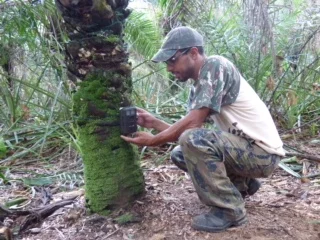Ongoing Projects
Fazenda Barranco Alto has multiple ongoing research projects, our two main ongoing projects include the Jaguar Research Project and the Giant Anteater.
Jaguar
The Jaguar Research Project
Jaguars of the Rio Negro Project - Projeto Onças do Rio Negro goal is to better understand how and what jaguars need to live and what measures can be taken to mitigate the conflict between farmers and cattle predators or how we can live together.
Furthermore the general goal of this research involves the understanding and monitoring of jaguar ecology, demography, population dynamics and its relation with human activities such as cattle ranching and tourism.
More specifically this research includes:
Prey spectra
Investigate prey abundance
Quantify and qualify predation
Evaluate jaguar predation impact upon domestic livestock
Describe jaguar activity patterns
Identify seasonal home-range and characterize habitat use
Characterize population dynamics
Evaluate the interaction of jaguars with humans (locals and tourists)
MATERIAL AND METHODS
Camera trapping
Infra-red sensor activated cameras are distributed on the study area to count systematically potential prey and jaguar abundance. Capture-recapture models using photographed individuals will be used to estimate and monitor the jaguar populations.
Capture
We intend to capture 5 jaguars in a 20 km radius from Fazenda Barranco Alto´s main site.
During the jaguar capture biological materials for genetic and epidemiological analyses will be collected. Physical evaluation, weight and dental conditions will also be measured.
Radio Telemetry
Adult jaguars will be fitted with a GPS collar with UHF communication.
With a GPS collar it will be possible to record a wide variety of ecological data, including information on hunting attempts, kills, reproductive behaviour, territorial activity and activity patterns.
Diet Analysis
Through skat collection and kill analysis, the project aims to determine further the Jaguars behaviour.
Activity, movement patterns, habitat use and home-range
Activity, movement patterns, habitat use and home-range will be interpreted after geo-location, date and time obtained by photographs and telemetry.
Understanding the dynamics of home-range size through different flooding seasons combined with prey abundance data will permit a better evaluation of the jaguar population dynamics in this sub-region of the Pantanal, as well as its movement patterns and territoriality.
Prey abundance
Prey abundance will be investigated based on photographic rates of potential jaguar prey with infra-red camera traps.
Population dynamics
Long-term studies of animal populations in this region are non-existent. This is especially true for large carnivores whose lifespan, large home ranges, and elusive nature make them difficult to study. Yet long-term population studies yield the baseline demographic data necessary to understand the factors responsible for changes in population size over time and to construct population viability analyses or risk assessments for the conservation of a species.
Although collared and photo-marked animals may represent only part of the local population it will aid on the understanding of the general population structure, density and reproduction.
A combination of capture-mark-recapture models using camera-traps, home-range size and overlap estimates of identified photo-marked individuals will yield density information.
The monitoring of collared and photo-marked individuals, especially females, will provide population parameters such as births, deaths and immigration.
Giant Anteater project
Lydia Mocklinghoff is present at Fazenda Barranco Alto conducting research between June and August, to learn more please visit her website and blog.



